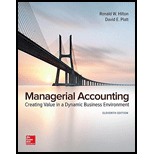
“We really need to get this new material-handling equipment in operation just after the new year begins. I hope we can finance it largely with cash and marketable securities, but if necessary we can get a short term loan down at MetroBank.” This statement by Beth Davies-Lowry, president of Intercoastal Electronics Company, concluded a meeting she had called with the firm’s top management. Intercoastal is a small, rapidly growing wholesaler of consumer electronic products. The firm’s main product lines are small kitchen appliances and power tools. Marcia Wilcox, Intercoastal’s General Manager of Marketing, has recently completed a sales

Jack Hanson, the assistant controller, is now preparing a monthly budget for the first quarter of 20x1. In the process, the following information has been accumulated:
- 1. Projected sales for December of 20x0 are $400,000. Credit sales typically are 75 percent of total sales. Intercoastal’s credit experience indicates that 10 percent of the credit sales are collected during the month of sale, and the remainder are collected during the following month.
- 2. Intercoastal’s cost of goods sold generally runs at 70 percent of sales. Inventory is purchased on account, and 40 percent of each month’s purchases are paid during the month of purchase. The remainder is paid during the following month. In order to have adequate stocks of inventory on hand, the firm attempts to have inventory at the end of each month equal to half of the next month’s projected cost of goods sold.
- 3. Hanson has estimated that Intercoastal’s other monthly expenses will be as follows:
 In addition, sales commissions run at the rate of 1 percent of sales.
In addition, sales commissions run at the rate of 1 percent of sales. - 4. Intercoastal’s president, Davies-Lowry, has indicated that the firm should invest $125,000 in an automated inventory-handling system to control the movement of inventory in the firm’s warehouse just after the new year begins. These equipment purchases will be financed primarily from the firm’s cash and marketable securities. However, Davies-Lowry believes that Intercoastal needs to keep a minimum cash balance of $25,000. If necessary, the remainder of the equipment purchases will be financed using short term credit from a local bank. The minimum period for such a loan is three months. Hanson believes short-term interest rates will be 10 percent per year at the time of the equipment purchases. If a loan is necessary, Davies-Lowry has decided it should be paid off by the end of the first quarter if possible.
- 5. Intercoastal’s board of directors has indicated an intention to declare and pay dividends of $50,000on the last day of each quarter.
- 6. The interest on any short-term borrowing will be paid when the loan is repaid. Interest on Intercoastal’s bonds is paid semiannually on January 31 and July 31 for the preceding six-month period.
- 7. Property taxes are paid semiannually on February 28 and August 31 for the preceding six-month period.
Required: Prepare Intercoastal Electronics Company’s
- 1. Sales budget:

- 2. Cash receipts budget:

- 3. Purchases budget:

- 4. Cash disbursements budget:
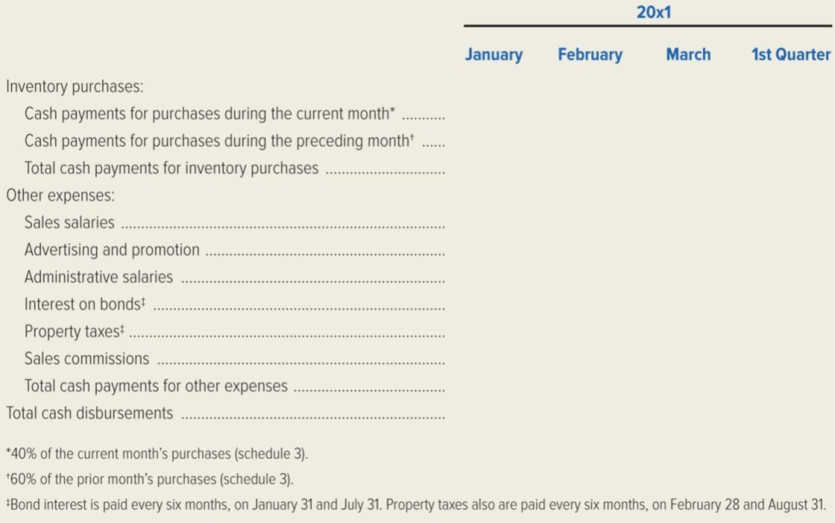
- 5. Complete the first three lines of the summary
cash budget . Then do the analysis of short-term financing needs in requirement (6). Then finish requirement (5). Summary cash budget:
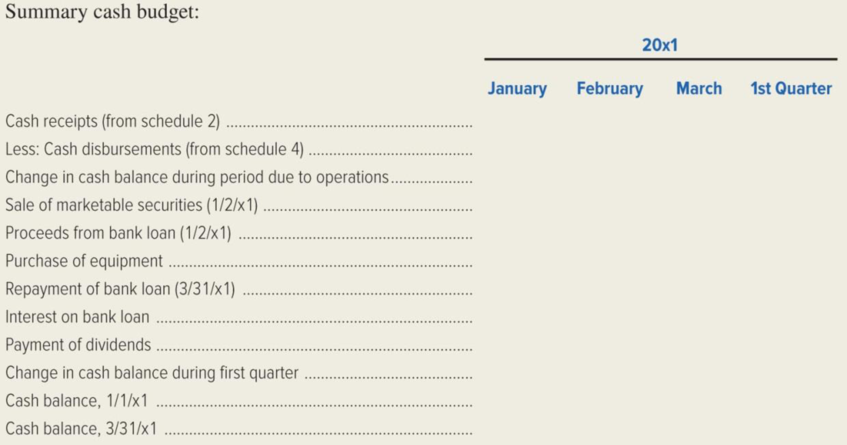
- 6. Analysis of short-term financing needs:

- 7. Prepare Intercoastal Electronics’
budgeted income statement for the first quarter of 20x1. (Ignore income taxes.) - 8. Prepare Intercoastal Electronics’ budgeted statement of
retained earnings for the first quarter of 20x1. - 9. Prepare Intercoastal Electronics’ budgeted balance sheet as of March 31, 20x1. (Hint: On March31, 20x1, Bond Interest Payable is $5,000 and Property Taxes Payable is $900.)
1.
Prepare a sales budget.
Explanation of Solution
Sales budget: This budget is prepared by the organization for the yearly or monthly basis as per need. It includes all the estimated revenues from the entire operating source.
Sales budget is prepared to estimate or project the sales in dollars and units for a particular period of time.
Prepare a sales budget:

Table (1)
2.
Prepare a cash receipts budget.
Explanation of Solution
Cash receipts Budget: The cash budget is a part of the financial statements which is a plan for the cash receipts for a particular accounting period. This budget gives an estimation of all the cash inflows of a business for the given financial period.
Prepare a cash receipts budget:
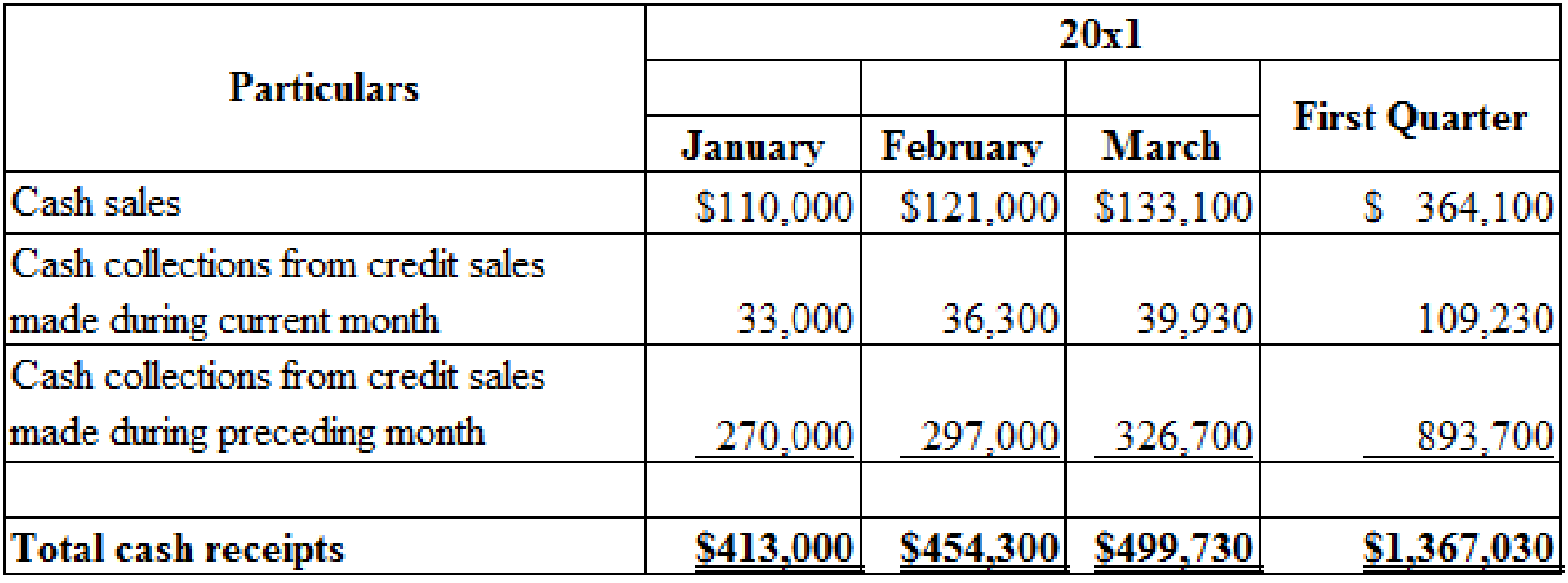
Table (2)
Working note 1:
20x1:
Calculate the cash collection from credit sales made during current month:
January:
February:
March:
Working note 2:
20x1:
Calculate the cash collection from credit sales made during previous sales:
January:
February:
March:
3.
Prepare a purchases budget.
Explanation of Solution
Prepare a purchases budget:
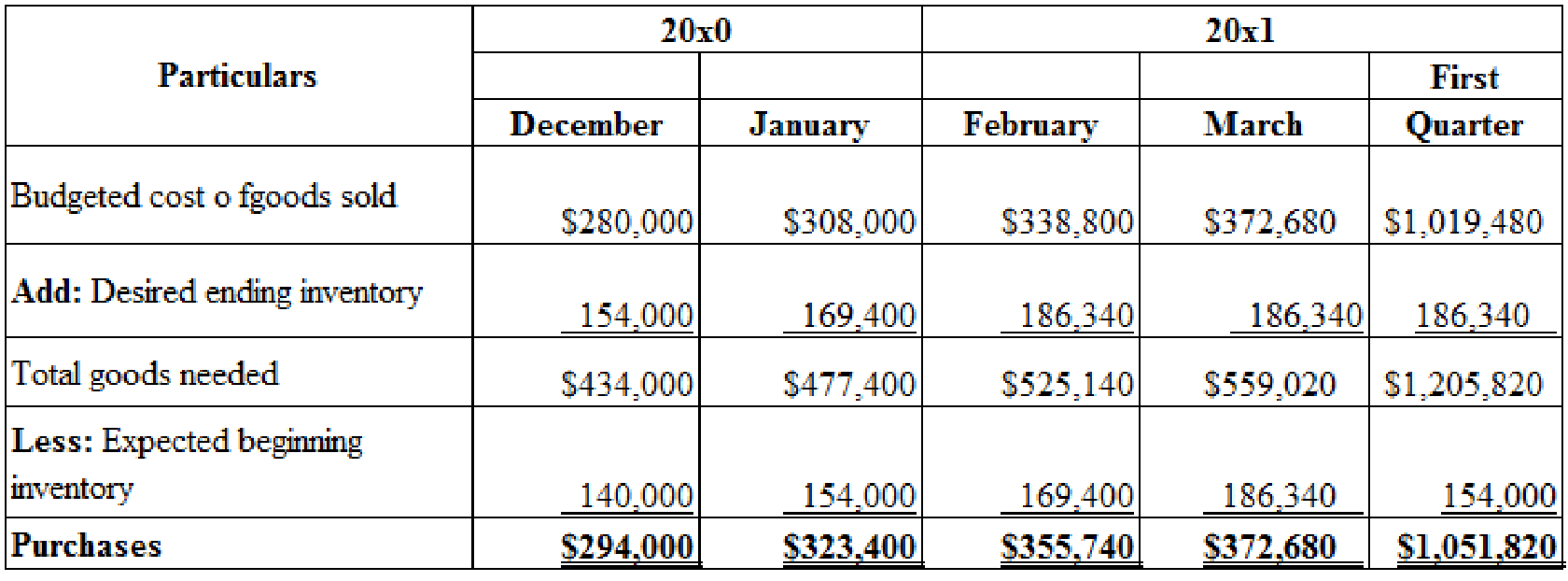
Table (3)
Working note 1:
Calculate the expected beginning inventory for December:
4.
Prepare a cash disbursement budget.
Explanation of Solution
Cash payments for purchases: This Schedule is prepared for the estimation of the cash payment for purchase for the period. This includes all probable cash payment.
Budgeted cash disbursement: Budgeted cash disbursements are the cash outflows expected for a budgeted period.
Prepare a cash disbursement budget:
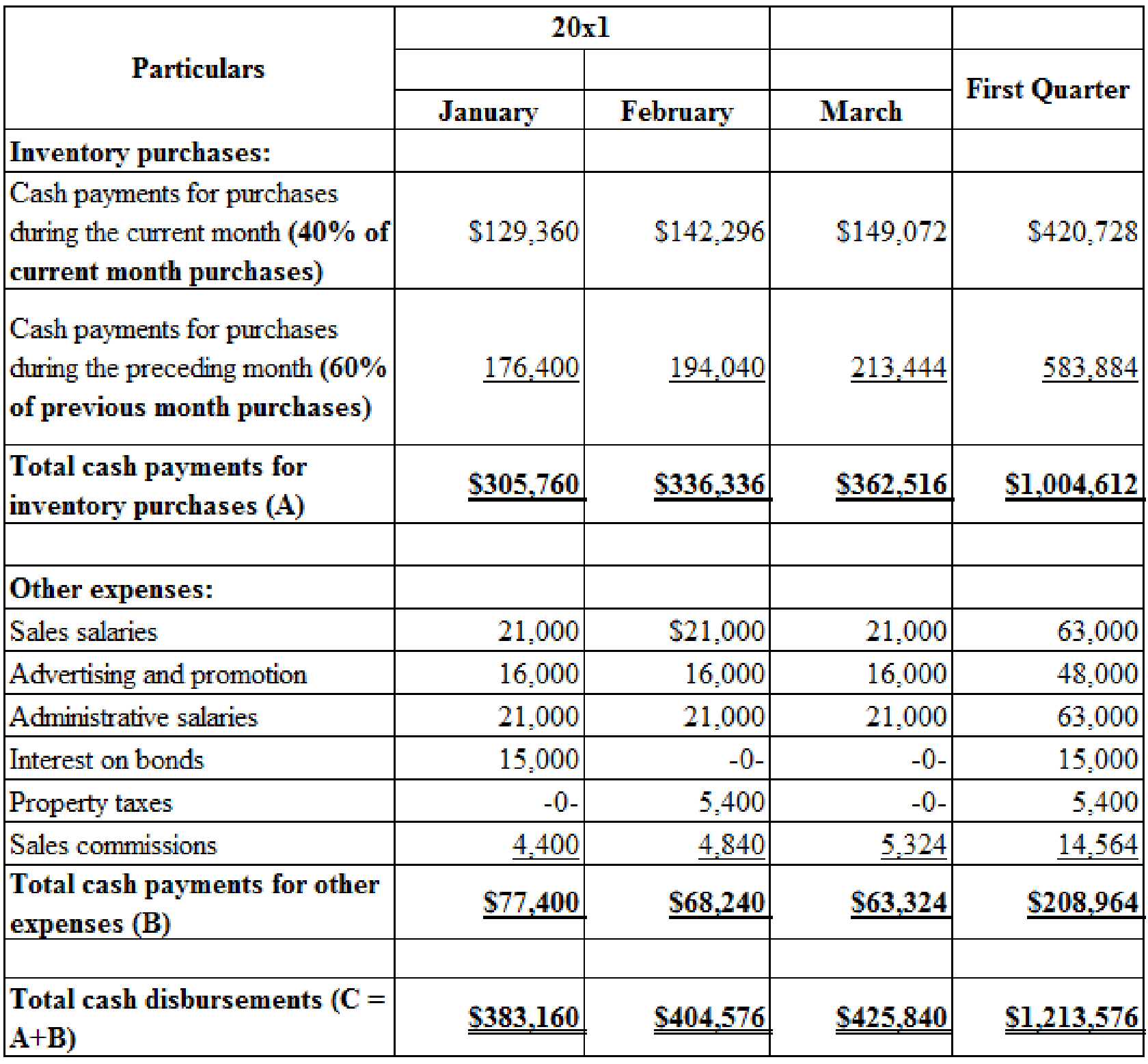
Table (4)
Working note 1:
Calculate the amount of interest on bonds:
5.
Prepare a cash budget.
Explanation of Solution
Cash Budget: Cash budget shows the expected cash inflows and cash outflows for a budgeted period.
Prepare a cash budget:
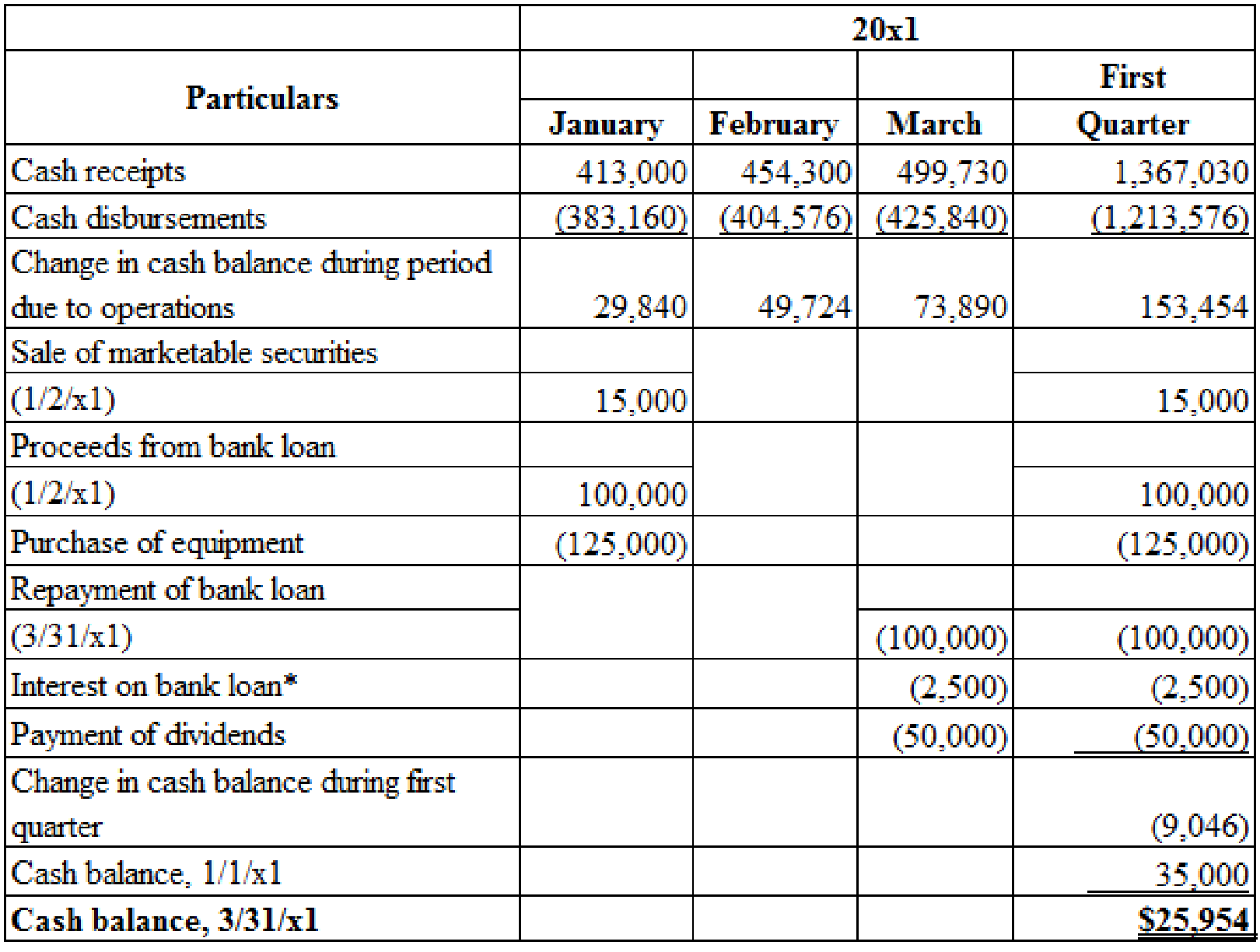
Table (5)
6.
Analyze the short-term financing needs.
Explanation of Solution
Analyze the short-term financing needs:
| Particulars | Amount ($) |
| Projected cash balance as of December 31, 20x0 | 35,000 |
| Less: Minimum cash balance | 25,000 |
| Cash available for equipment purchases | 10,000 |
| Projected proceeds from sale of marketable securities | 15,000 |
| Cash available | 25,000 |
| Less: Cost of investment in equipment | 125,000 |
| Required short-term borrowing | $(100,000) |
Table (6)
7.
Prepare I Electronics budgeted income statement for the first quarter of 20x1.
Explanation of Solution
Budgeted Income Statement: The statement that indicates the expected profitability of operations for the budget period is known as the budgeted income statement. It also provides the basis for evaluating the performance of a company, and act as a call to action.
Prepare I Electronics budgeted income statement for the first quarter of 20x1:
| I Electronics | ||
| Budgeted Income Statement | ||
| For the First Quarter of, 20x1 | ||
| Particulars | Amount ($) | Amount ($) |
| Sales revenue | 1,456,400 | |
| Less: Cost of goods sold | 1,019,480 | |
| Gross margin | 436,920 | |
| Selling and administrative expenses: | ||
| Sales salaries | 63,000 | |
| Sales commissions | 14,564 | |
| Advertising and promotion | 48,000 | |
| Administrative salaries | 63,000 | |
| Depreciation | 75,000 | |
| Interest on bonds | 7,500 | |
| Interest on short-term bank loan | 2,500 | |
| Property taxes | 2,700 | |
| Total selling and administrative expenses | 276,264 | |
| Net income | $160,656 | |
Table (7)
8.
Prepare I Electronics budgeted statement of retained earnings for 20x1.
Explanation of Solution
Retained earnings: Retained earnings are that portion of profits which are earned by a company but not distributed to stockholders in the form of dividends. These earnings are retained for various purposes like expansion activities, or funding any future plans.
Prepare I Electronics budgeted statement of retained earnings for 20x1:
| I Electronics | ||
| Budgeted Statement of Retained Earnings | ||
| For the First Quarter of, 20x1 | ||
| Particulars | Amount ($) | Amount ($) |
| Retained earnings, 12/31/x0 | $107,500 | |
| Add: Net income | 160,656 | |
| Subtotal | 268,156 | |
| Less: Dividends | 50,000 | |
| Retained earnings, 12/31/x1 | $218,156 | |
Table (8)
9.
Prepare I Electronics budgeted balance sheet as of March 31,20x1.
Explanation of Solution
Budgeted Balance Sheet: Budgeted Balance Sheet is one of the budgeted financial statements which summarize the budgeted assets, the liabilities, and the Shareholder’s equity of a company at a given date.
Prepare I Electronics budgeted balance sheet as of March 31,20x1:
| I Electronics | |
| Budgeted Balance Sheet | |
| March 31, 20x1 | |
| Assets | Amount ($) |
| Cash | 25,954 |
| Accounts receivable | 359,370 |
| Inventory | 186,340 |
| Building and equipment (net of accumulated depreciation | 676,000 |
| Total assets | $1,247,664 |
| Accounts payable | 223,608 |
| Bond interest payable | 5,000 |
| Property taxes payable | 900 |
| Bonds payable | 300,000 |
| Common stock | 500,000 |
| Retained earnings | 218,156 |
| Total liabilities and stockholders' equity | $1,247,664 |
Table (9)
Working note 1:
Calculate the amount of accounts receivable:
Working note 2:
Calculate the amount of buildings and equipment:
Working note 3:
Calculate the amount of accounts payable:
Want to see more full solutions like this?
Chapter 9 Solutions
Managerial Accounting: Creating Value in a Dynamic Business Environment

 AccountingAccountingISBN:9781337272094Author:WARREN, Carl S., Reeve, James M., Duchac, Jonathan E.Publisher:Cengage Learning,
AccountingAccountingISBN:9781337272094Author:WARREN, Carl S., Reeve, James M., Duchac, Jonathan E.Publisher:Cengage Learning, Accounting Information SystemsAccountingISBN:9781337619202Author:Hall, James A.Publisher:Cengage Learning,
Accounting Information SystemsAccountingISBN:9781337619202Author:Hall, James A.Publisher:Cengage Learning, Horngren's Cost Accounting: A Managerial Emphasis...AccountingISBN:9780134475585Author:Srikant M. Datar, Madhav V. RajanPublisher:PEARSON
Horngren's Cost Accounting: A Managerial Emphasis...AccountingISBN:9780134475585Author:Srikant M. Datar, Madhav V. RajanPublisher:PEARSON Intermediate AccountingAccountingISBN:9781259722660Author:J. David Spiceland, Mark W. Nelson, Wayne M ThomasPublisher:McGraw-Hill Education
Intermediate AccountingAccountingISBN:9781259722660Author:J. David Spiceland, Mark W. Nelson, Wayne M ThomasPublisher:McGraw-Hill Education Financial and Managerial AccountingAccountingISBN:9781259726705Author:John J Wild, Ken W. Shaw, Barbara Chiappetta Fundamental Accounting PrinciplesPublisher:McGraw-Hill Education
Financial and Managerial AccountingAccountingISBN:9781259726705Author:John J Wild, Ken W. Shaw, Barbara Chiappetta Fundamental Accounting PrinciplesPublisher:McGraw-Hill Education





